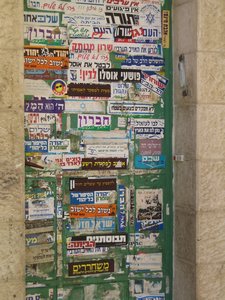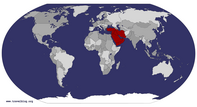Advertisement

 Hebron door
Hebron door
This door is plastered with stickers supporting settlers in Hebron.Last week we had a remarkable opportunity through Mandel to visit with four very different representatives of the settler movement in the West Bank. As I have done in my descriptions of my visits to Bethlehem ("Visit to Bethlehem") and Hebron ("Living on the Seam"), I will once again tell you what I saw and the stories of the people we met and let you draw your own political conclusions. But first a few comments:
It is important to note that despite the fact we participated on two different political tours with Mandel, they do not represent "the two sides" of the Israeli-Palestinian conflict. Neither side is just one side. When we met with Palestinians, we met with people engaged in peace work, not with Hamas spokesmen or extremists who reject Israel's right to exist. Likewise, settlers represent a slice of Israeli life. Comparing this experience to our experience in Bethlehem is comparing apples and oranges; they may both be fruit, but the helpfulness of the analogy ends there.
Which leads me to my second comment. One of the things that most surprised me (which in retrospect should not have surprised me at all) was the range of opinions

 Hebron playground
Hebron playground
Hopscotch and barbed wireamong the settlers. The settler movement is usually presented as a homogeneous movement. But despite the fact that all four of the people we met are Orthodox Zionists, the rule that applied was the "two Jews, three opinions" guideline. It was a good reminder about making generalizations.
We had been preparing for the visit for several weeks. One of the faculty members at Mandel has had experience in several settlements, including studying at the yeshiva in Hebron; he currently lives in Gush Etzion, a collection of four settlements just southeast of Jerusalem (more about the Gush below). He showed us two films made by settlers. One was about life during the second intifada and a young couple's determination to stay in their home in a settlement despite regular sniper fire, the brutal murders of friends and family members and a growing question of support from the larger Israeli population. The other film was about "Hilltop Youth," a group of alienated youth who are deeply disillusioned about their parents' Zionist dreams, the Israeli government and the army, and set up outposts on hilltops in the West Bank, sometimes accompanied by violence against neighboring Palestinians.
One of the things that

 Jewish neighborhood in Hebron
Jewish neighborhood in Hebron
The houses at the top of the photo are Palestinian homes.most impressed me about this faculty member is his ability to listen to opposing views with openness and curiosity, a complete suspension of judgment and a consistently friendly demeanor. Many of the Fellows are on the left side of the political spectrum and we had a very interesting conversation about two different social justice approaches: Do we better serve justice by firmly taking a principled stance on something that is important to us or by listening to someone we strongly disagree with with an open and non-judgmental heart? My general approach to this kind of paradox is to answer "yes." That is, we need to discern when we need to take a principled stance and when to really listen. We were inspired by Ido to use this day to really listen.
Our first visit was to Hebron. We first walked through a couple of the Jewish "neighborhoods," or small groups of apartments, where the settlers live. Hebron is the only Palestinian city where a few hundred Jews live in the center of the town in an environment of palpable tension and signs of past violence everywhere. We walked down the streets and noticed plaque after plaque noting where Jews
had been killed. We visited a museum at Hadassah House, the core of the Jewish presence in Hebron, which commemorated the massacre of the Jewish community by Arabs in 1929. There were gruesome photos of survivors displaying their wounds, including severed limbs.
We then went to the Shavey Hevron Yeshiva where we met with the head of the yeshiva. He was a gentle, soft-spoken man who told us that the yeshiva is a place where young men come to study not for any kind of certification or degree, but for the benefit of their souls. Hebron is where Abraham lived and is buried; he is the model of unity and loving-kindness. Walking in the same place that Abraham lived is powerful; the stones themselves help his students identify more strongly with the stories of Genesis and teach them how to follow Abraham's loving example. He admitted that his presence in Hebron might be harmful to others, but that is not his goal. Peace to him is not a political position. Instead it is a vision of redemption which might come next year or in a thousand years. He said that he believes that ultimately the yeshiva's presence in Hebron
will bring blessing to the entire world, including the Palestinians.
From Hebron we went to Migdal Oz, a settlement in Gush Etzion, to visit a women's Beit Midrash (or school of Talmud learning). We met with the head of the school, an erudite and authoritative woman in her 40's. She told us about the challenges and developments she has been able to lead in the serious education of Orthodox women. When we started asking her about living in a settlement, at first she resisted the premise of the questions. She doesn't think of the Gush as a settlement; she lives in a bedroom suburb of Jerusalem that happens to lie across the Green Line and doesn't feel like a settler. She would not live in Hebron; she has the right to live there, but she doesn't think it is right or wise to live there. But slowly she began reflecting about what it does in fact mean for her to live in the Gush. She told us that she sees how Palestinians have to stand in long lines at checkpoints and that it is painful to see. She even told us that she was embarrassed to find in herself

 Terracing
Terracing
It is easy to see why people fall in love with this land - it is so beautiful!the same revulsion at the idea of intimate interaction with Arabs and at the idea of eating non-kosher food. When she realized that, she decided it is important for her to get to know Arabs on a personal level; she understands she is paying a moral price for living where she does. But she pointed out the complexity. Some Israelis in uncontested West Jerusalem live in houses that were owned by Arabs before 1948. She lives on land that was open fields. What is the moral distinction? She asked if she leaves the Gush, will the problems end? She ended by saying that the price that settlers pay is a more limited morality - and then suggested that she might do a special two-day program for her students on this topic so that they can struggle with it more openly.
The third person we met with was one of the film makers. She was a lovely young woman who had grown up in a settlement and her film was the one about life during the second intifada. She has subsequently made a second film about the expulsion of the settlers from Gaza. This was a terrible blow for her,

 Sde Boaz
Sde Boaz
This is an illegal outpost. There is a standing demolition order to remove it, but the 14 or so families don't believe it will be enforced.a betrayal of the Jewish people by the Israeli government. She spoke bitterly about "exile-like thinking." She said that the Arabs want to destroy us. They only understand power. She used to have more sympathy for them, but during the second intifada, she realized that any semblance of friendliness was just a guise for a murderous intent. Exile-like thinking leads Jews to find it easier to identify with our enemies than with our own pain, but really, our enemies are only here as a test for us to rediscover our true destiny which is ultimately to be a light unto the nations. She said that what she had learned from the expulsion of the settlers from Gaza was that the creation of a secular Jewish state was not sufficient. Instead, it is important to work for a government whose laws are based on the Torah. To accept anything else is to settle for too little.
After our conversation with the film maker, we traveled to an illegal outpost called Sde Boaz. It was a small collection of caravans on a hillside above a larger, more suburb-like settlement. We met there in the home of a man who is a poet, a creative writing and Chassidut teacher and a laughter-yoga instructor. The house was very small and decorated with tambourines, a border of seashells around the doorway and a picture of a rabbi. On the refrigerator was a magnet that quoted Ecclesiastes, "A time to love." The poet told us he was born in a settlement; this land is his native land. But there are also other people who were born on this land. He believes that there is room for everyone if there is room in people's hearts. So he has started a new organization called "Eretz Shalom," or "Land of Peace." He believes that everyone must give up a little of their dreams and shift their paradigms. Neither a "Greater Israel" nor a two state solution is based in current reality. Instead, Jews and Palestinians must seek common ground; everyone is a human being, connected to God and connected to the land. He believes that peace is not created by outsiders or by governments. Peace comes from personal encounters. He told us that he had recently participated in joint settler/Palestinian demonstrations against the separation wall. He was also the only one of the four who said that he loves the land of Israel, but he would be prepared to live in a Palestinian state.
I must admit, it was not always easy to listen to some of these voices with an open and non-judgmental perspective. The thing that most struck me is how we all live in a bubble - a bubble that protects our way of life and worldview, that keeps us from really listening to those who have different worldviews and who live different kinds of lives. Of the four people we met with, I was most impressed by the director of the women's yeshiva because she was so unflinchingly honest and aware of her bubble and was prepared to take action towards teaching others in her own community. Surely that is the first step towards making the world a more compassionate, more just place.
Advertisement
Tot: 0.165s; Tpl: 0.013s; cc: 9; qc: 50; dbt: 0.0934s; 1; m:domysql w:travelblog (10.17.0.13); sld: 1;
; mem: 1.2mb










Heather
non-member comment
I really enjoyed your post about Mandel, Hebron, etc. It was so detailed and gave wonderful insight to what is going on in that part of the world. My blog is looking for travel reviews (including fantastic social commentary like yours!), photos, etc, to share with other travelers. If you have the time, check it out at dirty-hippies.blogspot.com, or email me at dirtyhippiesblog@gmail.com. Continued fun on your travels! Heather :)